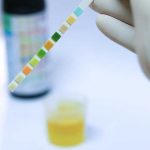Tramadol, sold under the brand names Ultram and Conzip, is an opioid medication used to treat chronic or moderate to severe pain.
The Drug Enforcement Administration (DEA) classifies most opioids as schedule II controlled substances with a high risk of abuse. However, Tramadol is a schedule IV controlled substance, which means it has a lower risk of abuse than other opioids.
Although it is considered less addictive than other opioids, tramadol can still be abused and lead to tolerance, dependence, and addiction. If you or a loved one is struggling with tramadol abuse, a healthcare professional can connect you with a treatment center that fits your needs.
How Is Tramadol Habit-Forming?
Tramadol is an opioid analgesic (painkiller) and central nervous system depressant that slows brain activity.
When you take tramadol, it activates opioid receptors in the brain and increases dopamine, a brain chemical involved with pleasure and reward. At first, tramadol may produce euphoric and relaxing effects.
However, using tramadol for a long period of time can cause your brain to produce less dopamine and rely on the drug to function. You may also build a tolerance to tramadol that requires higher doses to maintain the same pleasurable effects of the drug.
Someone who becomes addicted to tramadol may also experience intense cravings and continue to take the drug to avoid withdrawal symptoms. Addiction can make it difficult to stop taking opioids, even if it causes harm or interferes with daily life.
Effects Of Tramadol
Tramadol may be abused for its pain-relieving and euphoric effects but it can also cause numerous adverse side effects. Side-effects vary depending on the dose, how you use tramadol, and if you combine it with other substances.
Side-effects of Tramadol include:
- drowsiness
- constipation
- dry mouth
- headache
- shakiness
- mood changes
According to the Food and Drug Administration (FDA), mixing tramadol with antidepressants increases the risk of a severe adverse reaction known as serotonin syndrome.
Serotonin syndrome is a potentially life-threatening condition that is a result of high levels of serotonin (a naturally occurring brain chemical) in the body.
Tramadol Overdose
Tramadol was considered to be a safer alternative to other opioids, like oxycodone, hydrocodone, and codeine. However, the Substance Abuse and Mental Health Services Administration (SAMHSA) found that the number of emergency room visits involving tramadol increased significantly between 2005 and 2011.
Taking too much of a depressant drug can cause shallow breathing, low blood pressure, and loss of consciousness. If you think someone may be suffering from an opioid overdose, seek medical attention and administer naloxone (Narcan) if you have it on hand.
Tramadol Dependence
Frequent tramadol abuse can result in physical dependence, which means the body needs the drug to function normally. If you become dependent, you may experience withdrawal symptoms if you stop taking it.
Tramadol withdrawal symptoms include:
- cravings
- anxiety
- sweating
- trouble sleeping
- runny nose
- goosebumps
- nausea
- diarrhea
If you are prescribed tramadol and become physically dependent, your doctor may help you come off the drug safely by tapering your dose. A taper involves gradually lowering the dose of tramadol and monitoring for withdrawal symptoms.
Risk Factors For Tramadol Addiction
Not everyone who is prescribed tramadol will become addicted to it. However, certain environmental, genetic, and biological factors may increase the risk of developing a substance use disorder (SUD), also known as addiction.
Risk factors for addiction may include:
- history of drug abuse
- taking more than the prescribed amount
- crushing, snorting, or injecting the drug
- having a co-occurring mental health disorder
- family history of addiction
Tramadol Addiction Treatment
Tramadol can be addictive, even if you’re prescribed it by a doctor and take it as directed. If you think you or a loved one may be struggling with tramadol addiction, help is available. An addiction treatment program can help you learn to cope with cravings and live drug-free.
Medical Detox Program
If you are dependent on opioids, your addiction treatment program is likely to begin with a detoxification program. A medical detox program provides 24/7 supervision during the withdrawal process.
Inpatient Rehab
Inpatient treatment is a highly structured program that offers a daily schedule of activities that help you build a foundation of skills for long-term recovery. Depending on your treatment plan, you may be involved with behavioral therapy, support groups, and individual counseling.
Outpatient Rehab
Outpatient treatment varies in intensity but may involve several treatment sessions each week. During each session, you will engage in a wide range of treatment services, including group therapy, behavioral therapy, and family therapy.
At Northeast Addictions Treatment Center, we offer a variety of outpatient treatment options. If you would like to learn more about opioid addiction treatment, please reach out to a specialist today.
Sources
- Food And Drug Administration (FDA) — Tramadol
- MMC: Psychiatry — Tramadol: Seizures, Serotonin Syndrome, And Coadministered Antidepressants
- National Library of Medicine: MedlinePlus — Tramadol
- Substance Abuse And Mental Health Services Administration (SAMHSA) — Emergency Department Visits For Drug Misuse Or Abuse Involving The Pain Medication Tramadol
Written by
Northeast Addition Editorial Team
©2024 Northeast Addition Center | All Rights Reserved
This page does not provide medical advice.





